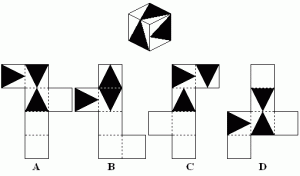Cocktail Tall Tale?
By: Shannon Laughlin
One of the fondest memories from my childhood was playing a “card deck” format workbook of brain teasers, called “Brain Quest.” The questions would often ask you to answer a riddle or move an object in your mind, and I felt such pride when I finished a deck. Little did I know then, but this sort of “workbook” was helping me practice my spatial reasoning and abilities, something that some research shows boys are significantly better at than girls. According to John’s Hopkins researchers, spatial abilities are “the capability to understand and remember the spatial relations among objects.” An example of a problem that tests spatial skills is below. Could a discrepancy between sexes in these skills lead to a discrepancy between the sexes in STEM field job representation? Nora Newcombe tries to answer this question in her essay, featured in the book Why Aren’t More Women in Science?. Despite the fact that I agree with Newcombe’s mentality on fixing the issue, I cannot agree with her main points due to overarching assumptions.
The title of Newcombe’s essay, “Straight Thinking about Spatial Sex Differences,” is misleading because most of her explanations are not straightforward at all: the very nature of this topic is complex, and her views are no exception. She begins by referring to sex differences in spatial function as a “cocktail party conversation” which petty chitchat revolves around, but admits that there is truth to this information. She brings up the controversial remarks of Larry Summers and agrees with his point of view, only with a twist. Like Summers, she believes the evidence that men are better than women at spatial reasoning, but specifies that these differences are not unchangeable. Essentially, Newcombe’s opinions are an incremental adaptation of Larry Summers’.
Newcombe’s first section was focused on explaining the reason why men have better spatial skills than women. From the start, Newcombe assumes that her audience is “on board” with the idea that men outperform women in spatial ability. She provided minimal evidence in the first paragraph and expected the readers to be familiar with the studies Larry Summers referred to in his hotly-debated comments. This can be seen as a flaw in her argument. Through taking this FYS course, I have seen several studies stating the opposite of what Newcombe refers to. An example of this is a study by Jennifer Lachance, where over 200 elementary-aged kids were tested for spatial abilities, and no considerable difference was found between the two sexes. Because of my exposure to articles such as this, Newcombe provides me no reason to believe that men have better spatial abilities than women. As for the reasons why she believes men outshine their female peers, Newcombe states many possibilities (X-linked genes, timing of puberty, a more lateralized brain, different sex hormones) but never really comes to a definite conclusion because of unclear data.
The next concentration of Newcombe’s essay is evolution. She wishes to provide an evolutionary based reason for why men would need better spatially abilities than women. All of the scenarios she provides are not backed up by research or data because it is hard to have concrete “data” when it comes to evolutionary reasoning. We can only make educated hypotheses by connecting observable aspects of our world to the past world. Newcombe does this by defining the sexes’ duties as “Man the Hunter” and “Woman the Gatherer,” but finds that both of these positions would require spatial skills equally. Next, she draws on a study with meadow voles suggesting that men need spatial skills to “get around” and have children with as many women as possible, but quickly refutes it because, well, humans are not meadow voles. Our structure of society and living is not the same. Thus, Newcombe does not reach an evolutionary explanation.
By this point in the essay, I wasn’t sure exactly where Newcombe was going with her ideas. Thus far, she’s only mentioned theories and no concrete justification from studies or data. And in places, she’s made assertions but had no data to back it up. For example, to explain that sex hormone levels and spatial skills are “accidentally” linked, she states that acne is also “accidentally” linked to males. I took this by surprise because I had never heard of a sex difference in acne, and Newcombe did not provide a citation to tell where she got that assumption. Upon further research, I even found studies which show that women are more affected by acne than men. For me, this made Newcombe lose significant credibility as an author.
After going through the main body of “evidence” (not really evidence, just theories), Newcombe’s essay improved for me. She uses her own research to explain that spatial skills can be improved, which is aligned with the data from the AAUW PowerPoint “Why So Few?.” This attitude makes me think she is an incremental theorist, just like essayist Virginia Valian, believing that knowledge can be expanded and is not fixed. Thus, Newcombe believes that this issue may be fixable with future methods of training and practice. She finishes off her essay by stating that it shouldn’t matter why the differences in spatial abilities exist, but that we should instead focus on educating to decrease the gap. Although I’m still not sold on the fact that there are significant differences, this conclusion explains why Newcombe never fully committed to one reason for them in her essay. She purposefully did not emphasis any real data because she believes our priorities should be elsewhere: education.
Despite the defects in Newcombe’s argument and the fact that she did not mention societal factors like gender schemas, I support her belief that education can improve one’s abilities and her drive to advance women’s involvement in STEM careers. I have to remember that as a woman interested in science myself, I probably carry significant bias relating to biological factors affecting the issue. Even if biological differences were the sole reason for the discrepancy, it would be hard to admit because it would degrade my status as a prospective scientist compared to my male peers, and make the issue something out of society’s control. Overall, this essay has not convinced me of the spatial differences between the sexes, but of the effectiveness in educating abilities to make the STEM careers feel accessible to everyone, whether male of female.
Images: http://www.psychometric-success.com/images/clip_image001_0048.gif
https://canadianbudgetbinder.files.wordpress.com/2013/09/brain-quest-kids.jpg
Other references: http://web.jhu.edu/cty/STBguide.pdf
www.sciencedaily.com/releases/2007/10/071019155627.htm
http://www.ncbi.nlm.nih.gov/pmc/articles/PMC2867482/
http://www.aauw.org/research/why-so-few/


